Samwel N. Mwenda
Department of data processing, ICT Directorate, Kenya National Bureau of Statistics, Nairobi, Kenya
Correspondence to: Samwel N. Mwenda, Department of data processing, ICT Directorate, Kenya National Bureau of Statistics, Nairobi, Kenya.
| Email: |  |
Copyright © 2015 Scientific & Academic Publishing. All Rights Reserved.
Abstract
A lot of studies have been done on smoking tobacco but a lot of emphasis have been on the current smokers and very little has been done on the past smokers. The past smokers can give us a better direction in determining the most effective method that can help the current tobacco smokers quit smoking. It is therefore the purpose of this research paper to find out from past tobacco users, the age at first initiation into smoking, how long they smoked, and how long it took them to quit smoking. The study also aims to find out the smoking pattern of the past smokers, and compare it with the smoking pattern of the current smokers and find out whether there is any. The two patterns of smoking include the daily smoker and the less than daily smoker patterns.
Keywords:
Age, Initiation, Pattern, Smoking
Cite this paper: Samwel N. Mwenda, A Study on Comparison of Current and Past Tobacco Smokers in Kenya and the Reasons Behind the Later Quitting, International Journal of Prevention and Treatment, Vol. 4 No. 1, 2015, pp. 14-21. doi: 10.5923/j.ijpt.20150401.03.
1. Introduction
Tobacco, botanically known as Nicotianatabacum is a perennial herbaceous plant. It is the most commonly grown of all plants in the Nicotiana genus. Its leaves are commercially grown in many countries. Itt grows to heights between 1 to 2 meters to be processed into tobacco products [1] These are processed and some are commercially manufactured into cigarettes which are consumed through smoking. Tobacco smoking is a risk factor for contracting multiple cancers particularly lung cancer [2] malnutrition and premature death [3] Limited data concerning smoking for kids under 12 is available. The peak years for first trying to smoke appear to be in the sixth and seventh grades (or between the ages of 11 and 13). A considerable number of children start smoking before the age of 11. [4] Smokers who start smoking during their early years form a significant percentage of heavy cigarettes users [5] Cigars contain many of the same carcinogens (cancer-causing agents) found in cigarettes. Cigar smoking causes cancers of the lung, mouth, throat, larynx (voice box), esophagus (swallowing tube), and the pancreas [6] Smoking effects should not be ignored since evidence suggests that there is a relationship between smoking and cancer number of diseases among them lung cancer. For example, in Germany, Müller (1939) found out that out of eighty six patients with lung cancer; only three were nonsmokers, while fifty six of them were heavy smokers. Among eighty six healthy men of the same age group, there were fourteen nonsmokers and only thirty one heavy smokers [7]. A similar study was carried out by Schrek et al in America and reported that 14.6% of eighty two male patients with cancer of the lung were nonsmokers against 23.9% of 522 male patients admitted with cancer of sites other than upper respiratory and digestive tracts [8]. Although we cannot use these 2 case studies to conclude the relationship between tobacco and lung cancer, they all point out towards the same conclusion, tobacco is the main cause of lung cancer [9]. An earlier age of smoking initiation means that the potential duration of smoking throughout a person’s lifespan is increased. Therefore, such a person’s risk of developing lung cancer or experiencing a range of risk factors and smoking-related health problems in adulthood is also increased [10] Therefore, it is always for the benefit of a smoker to quit smoking to minimize the chances of getting the diseases that are associated with smoking. This will result into health improvement of the smoker, and probably reduce their probability of getting smoking related health diseases. According to WHO, if the current smoking trends continue then by the year 2020 the current figure of 4 million deaths due to smoking is expected to rise to 8.4 million deaths due to smoking [11]. When Zulu et al did his research paper on tobacco epidemic in Lusaka district in Zambia, he came to a conclusion that the district was on the first stage of the tobacco epidemic and thus guidance by the WHO FCTC for effective intervention be put in place before the epidemic turns unmanageable [12] Zambia is not different from Kenya where tobacco consumption is concerned. The two countries have similar acts that regulate the smoking of tobacco. Both countries have banned smoking in government buildings [13], and the sale of cigarettes to minors who are less than 16 years of age [14]. Zambia began anti-smoking tobacco campaigns in 1992. It accented to the WHO FCTC on 28th May 2008. Kenya did so in 2004.Problem statementTobacco smoking is a habit that is very easy to begin but then when it becomes addictive it becomes very hard to leave. Previous research has shown that over 80% of smokers show a lot of interest in attempting to quit smoking. This becomes very difficult for them because they are already addicts. In almost every country which has signed the FCTC, there are always methods that they have come up with to help their citizens who smoke to quit smoking. Therefore, the fact remains that smoking is very harmful, addictive and therefore we need very effective measures to control its addiction amongst people in every place. The various trends in smoking have also shown people start smoking very early, as early as 5years of age. This is very risky bearing in mind the ill health effects of smoking.Objectives of the studyGeneral objectiveTo find out how past smokers quit smoking and which methods they used.Specific objectives1. To find out whether gender and age of initiation of an individual to smoking leads to addiction to heavy smoking or light smoking.2. To find out whether reasons for quitting for Heavy Smokers are similar to Light Smoker.3. To find out whether marital status is associated with smoking daily or less than daily.4. To find out whether doctors’ advice during regular check-ups affects quitting for heavy smokers and light irregular smokers.Justification of the studyCampaigns have been launched extensively across many countries on a global scale to help smokers quit smoking. Information from past smokers could be very crucial in assisting current smokers to quit the habit. Even the manufacturers of the tobacco products acknowledge tobaccos’ health effects. The manufacturers even label their products “tobacco smoking is harmful to your health”. This shows a deep need to help the current smokers quit smoking by studying the past smokers. Limitations of the studyAlthough the study is about the past smokers, we don’t have information as to the people who initiated them into smoking. This information could be very important in identifying the key people who introduced the habit to them and compare it with the people who introduced the habit to the current smokers.
2. Materials and Methods
Study area and designThe study was conducted in Kenya between January and February 2014. Adults of 15 years and older were interviewed voluntary and were all eligible for the study. However since in Kenya adults are considered to be 18 years or older a consent was sought from the parents for the age group below 18 years before the interview was conducted. The study involved secondary analysis of data from the Global Audit Tobacco Survey (GATS) conducted in Kenya in 2014. The GATS is a household based sample survey of adults aged 15 years and above who are usual members of a household. Variables considered in the analysisStudy participants were asked whether they smoke tobacco or not. Those who answered yes to smoking tobacco were asked whether they did it on a daily basis or less than daily. Therefore, the current smoking patterns were divided into two categories: Heavy Smokers and Light Smokers. Those who had quit smoking were categorized as past smokers, thus, their smoking status was non-current smokers. Marital status was divided into 5 categories; single, married, separated, divorced and widowed.Data analysis and discussionsData from the GATS 2014 was analyzed using SPSS software version 20 and Microsoft Excel 2010. Results were presented using tables and graphs and the interpretation was based on the comparison of past smokers and current smokers.Past smokers marital status compared to current smokers marital statusTable 1. Past smokers marital status
 |
| |
|
From the secondary analysis of Kenya GATS 2014, the highest percentage of Heavy Smokers were the married 114(76.51%) followed by the widowed 19(12.75%) then by the single people 10(6.7%) and finally the separated and the divorced have equal number of people 3(2.013%). When it comes to the Light Smoker, the married still have the highest number 47(60.25%) followed by the single people 21(26.92%) then the widowed 6(7.6%) and finally the separated 4(5.13%). The divorced are at 0% showing that there was no divorced person who was less than daily smoker who quit smoking according to the sample. The overall past smokers who quit daily smoking were 149(65.64%) while the overall who were smoking less than daily and they quit was 78(34.36%).The study went a step further to investigate the percentage of the Heavy Smokers and Light Smoker against the total number of past smokers. Daily past smokers against the total past smokers for single, married, separated, divorced, widowed is 32.26%, 70.8%, 42.85%, 100%, 76% respectively. Light Smoker against the total past smokers for single, married, separated, divorced, widowed is 67.74%, 29.2%, 57.14%, 0%, 24% respectively. Unlike the case for Heavy Smokers where the largest group that quit was married, in the case of Light Smoker we have more single people quit than any other category. Current smoker marital statusTable 2. Current smokers marital status
 |
| |
|
Of the current total smokers, we have a huge number of single people who are Heavy Smokers than Light Smoker. This could have been caused by the fact that we had a bigger number of Light Smoker who quit smoking more than the Heavy Smokers. The number of married Light Smoker is similar to the number who quit, showing that there could have been an introduction of more Light Smoker to the married class. The study investigated the percentage of the current Heavy Smokers and current Light Smoker against the total number of the current total smokers. The study found out that current Heavy Smokers for single, married, separated, divorced, widowed is 68.18%, 83.5%, 94.6%, 66.67%, 66.67% respectively while that of Light Smoker against the total past smokers for single, married, separated, divorced, widowed is 31.81%, 16.50%, 5.4%, 33.33%, 33.33% respectively. Combining the number of separated, divorced and widowed together, we find out that the percentage of daily current smokers and less than daily current smokers is 84.48% and 15.52% respectively. This percentage is higher compared to the single and married current Heavy Smokers; which as previously stated is 68.18% and 83.50% respectively. This shows that the separated, widowed and divorced are more likely to engage in smoking than the married and the single. Previous research has shown that age can determine whether someone is likely to be a smoker. In this case the majority of the single people are basically the youths, then as the grow they get married, then as the years advances they could probably be widowed, divorced or separated and turn to smoking tobacco. Therefore, there could be a higher chance of having Heavy Smokers in the older age group as suggested by the bar graph 1.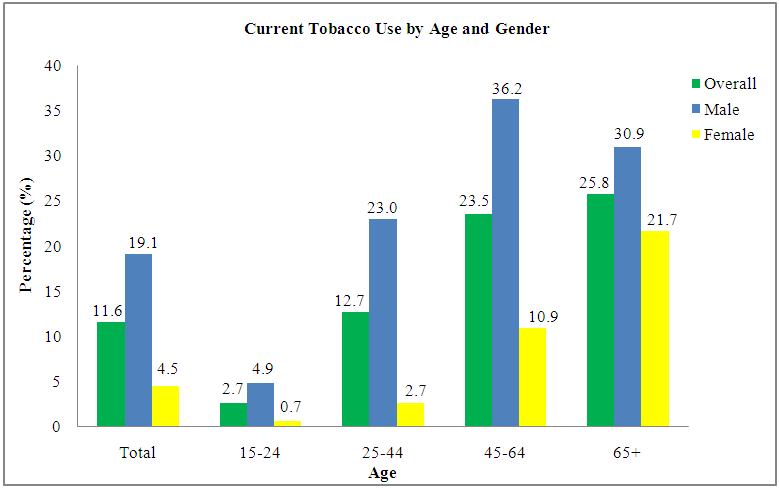 | Graph 1. Current tobacco use by age and gender |
Current tobacco use by age and genderOn the issue of current tobacco use by age and gender, the study found out that overall 11.6% of the populations are current tobacco users with men between 45-64 years topping the list of majority of smokers with 36.2%. The smallest age group where we have few smokers is between 15-24years. This is the age-group where the young adults are still going to secondary school, and some are in colleges and universities. This number increases especially for men from 4.9% to 23%. This covers the age where graduates from colleges get jobs. They have money to spend on luxurious things like smoking. This is also the age where there is a lot of social pressure to belong to a social class. The number of men increases further with 23.2% with the age group 45-64. This can be attributed to the fact that at this age there is an increase in family responsibility and men can find a way of reducing stress mainly by taking alcohol and smoking. There is also a lot of pressure as men try to figure out their retirement and how to maybe educate the remaining children with the few resources. Men are also worried of their pension and how they are going to survive in their old age. With ages 65+ the number of men falls with 5.3% to about 30.9% and in this age group, there is no a lot of money to spend on luxury since this is the retirement age. Also at this age some men have died due to tobacco related problems, thus the number of smokers continue to decrease in men. This is attributed by the fact that men started early to smoke so at this age the effects are at the peak. However, the number of women smokers continues to increase with increase in age. At age 15-24 the girl is still shy and knows smoking is only for men, but some choose to experiment smoking due to peer pressure especially in campus. We have new smokers at age 25-44 since the woman is now independent and they have freedom to do what they want and also the woman got a job and wants to hang out with a social class. The number is not very high since they are getting children and they need take care of them and teach them good morals. At age 45-65 the number of women smokers increase due to the fact that at this age we have a lot of divorces occurring, the woman feels more empowered and some can smoke to release stress or to prove equality with men. At the age of 65+ we have additional women smokers with an increase 10.8% and at this age we have widows whose husband have died and they may choose to indulge in smoking and also due to starting late to smoke, the effects of smoking are not yet at the peak.Past smokers reasons for quittingThe study wanted to find out from the past smokers what was their aim of quitting and the response varied depending on whether one was a daily smoker or less than daily smoker. The following pie chart summarizes the findings for the Heavy Smokers.The main reason for quitting in both daily and Light Smoker was that they realized that smoking was harmful to their health, this in percentage for daily and Light Smoker is 64.42% and 60.26% respectively. For the past Heavy Smokers the next main reason for quitting was for religious purposes, became too expensive, other reasons, pressure from close relatives, restriction on smoking and finally don’t know. The percentages are 12.08%, 9.40%, 8.05%, 3.36%, 2.01%, and 0.60% respectively. For the Light Smoker the reasons of quitting after health reason was other reasons, pressure from friends/relatives, became too expensive, religious purposes, restriction on smoking and don’t know. In percentage it is 16.67%, 12.82%, 3.85%, 3.85%, 1.28% and 1.28% respectively. The quitting pattern is different for the daily and Light Smoker. This is because some of the Heavy Smokers were Light Smoker before they started using tobacco daily. For both cases, a lot of emphasis should be directed to the health effects of smoking. This reason seems to cause people to stop smoking, whether; they are daily or less than daily. The pressure from close relatives and friends seem to work well in the case of less than daily smoker reason for quitting. T this mainly focuses on the young age group who could be in schools who are trying to copy the habit from their friends or parents. Therefore, relatives and friends need to be educated to know they have a major role to help in reducing smoking tobacco in the youths before they get addicted and become daily users. Religion played a very big role in making people to quit smoking in the case of Heavy Smokers at 12.08%. This shows that our religious centers are very vital in reducing tobacco smoking and the leaders need to emphasize the effects of smoking in churches mosques temples and other places of worship. Also raising tax on tobacco has an overall effect of minimizing the Heavy Smokers at 9.40%. Therefore, the government needs to put more taxes on tobacco products in order to reduce its accessibility by making tobacco very expensive. Other reasons for quitting tobacco smoking were given by the respondents. There were respondents who quit smoking because they did not like the habit of smoking. Other say they dint see any benefits of smoking/no importance/not helping at all. Others said they quit after getting a baby although they were just smoking for fun. Some Light Smoker had to quit because they felt they could end up getting addicted and it was difficult to stop after that. Others sighted traditional reasons for quitting, while others were afraid that tobacco smoking might make the take other dangerous drugs such as cocaine. Others were advised by the doctor to quit smoking while the other said they felt their house smelling bad because of tobacco and so they decided to stop the vice.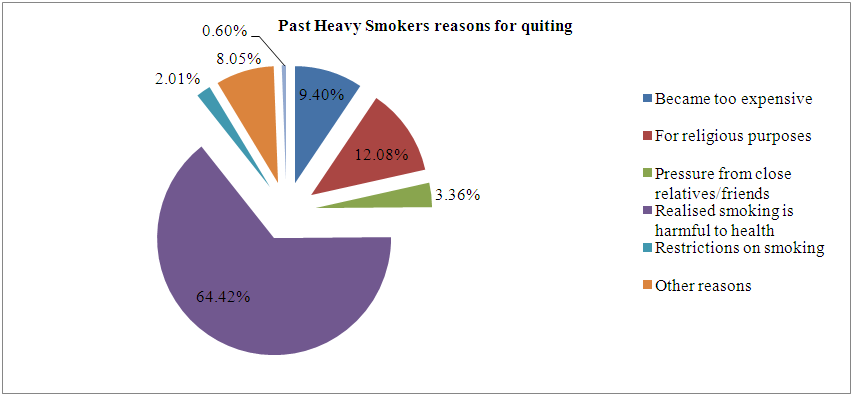 | Graph 2. Past tobacco heavy smokers with reasons for quiting |
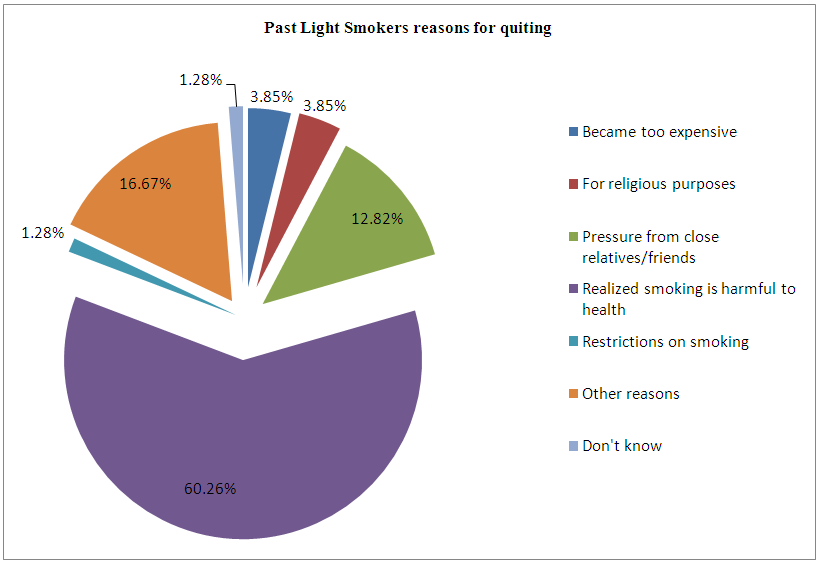 | Graph 3. Past tobacco light smokers with reasons for quitiing |
Past smokers quitting periodThe study wanted to find out the frequency in which past smokers used in order to quit smoking. The results are represented in the histogram below.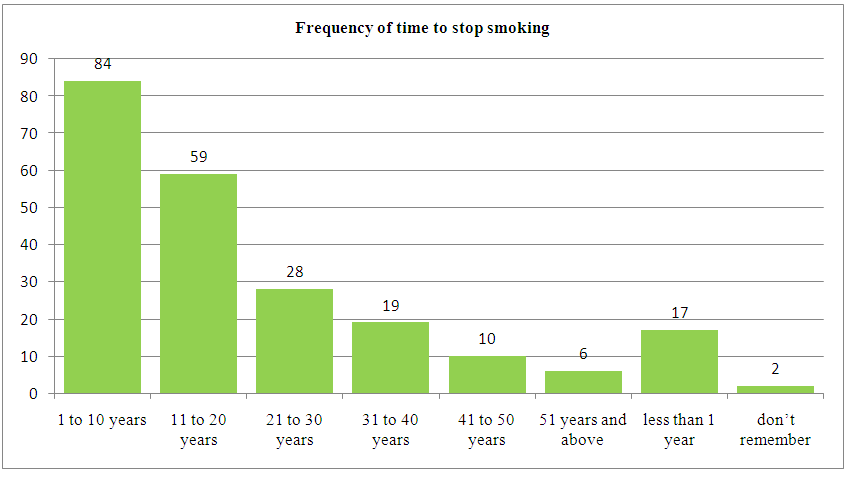 | Graph 4. Frequency of time to stop smoking by past smokers |
Tobacco is a very addictive substance. There are people who have been addicted to tobacco for over 50years. The study found out that only 2 (0.9%) people could not remember the time it took for them to quit while only 17(7.6%) people were able to quit in less than 1 year. The least recorded quitting period was 10 days while the most was 73 years. The largest group was the one that took between 1year to 10 years to quit with a frequency of 84(37.33%). This was followed by people who took between 11 and 20years at 26.22% then 21-30years at 8.4% 41-50 years at 4.44% then we have 51 years and above at 2.7%.Past smokers and age when started smoking tobacco daily compared to current smokersThe study intended to find out the various ages in which past smokers started to smoke.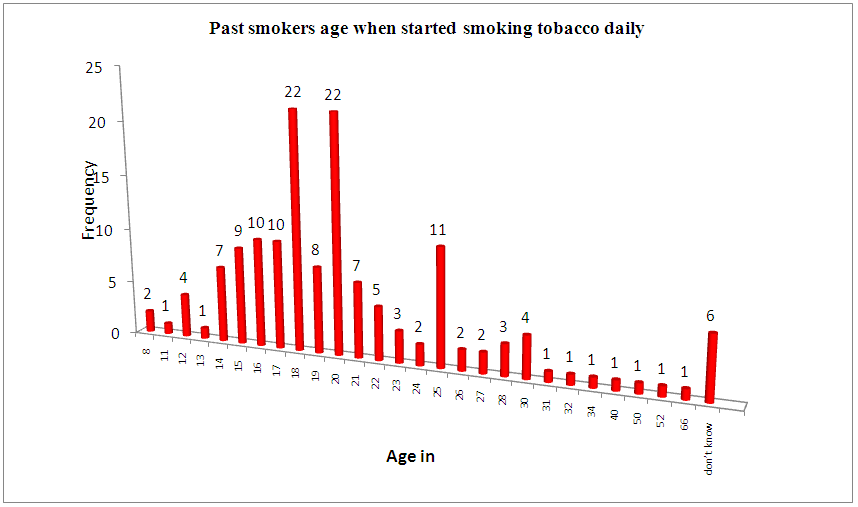 | Graph 5. Past smokers age of initiation into smoking tobacco daily |
The youngest age of respondents when they started smoking tobacco daily was 8years while the highest age of of respondents when they started smoking was 66 years. Majority of the past smokers started smoking between age 14 and 22 with the highest age of initiation being 18 and 22 years. This shows that most of the past smokers started smoking during their youth. The past smokers who did not know the age of initiation into daily smoking were 6 and most of them were aged 90years and above. This may have been the cause in the inability to estimate the age when they first smoked tobacco.Unlike the case of past smokers where the youngest age of smoking was 8years, the current smokers seem to have begun smoking quite earlier at the age of 5years. By age 11, the current smokers had 14 who had begun smoking at that age while the past smokers only 3 had begun smoking by age 11. This shows that as the time progresses, we have more young people getting initiated into daily smoking at a very early age. This is why it is very difficult for them to quit tobacco smoking since tobacco is a very addictive substance. Majority of the respondents in this category got initiated into daily tobacco smoking between the ages of 14-25. The cases of don’t know are high in the current Heavy Smokers than past, and mostly this is found in the advance age group of 90years and above who might not be in a position to recall their ages of first initiation into smoking.Past smokers and doctors visit compared to current smokersFor respondents who had visited a doctor within 1year, the study found out that for every 5responents who had visited a doctor, 2(40%) were Light Smoker while 3(60%) were Heavy Smokers. Of this kind of sample, 2 Light Smoker had visited the doctor 1 or 2 times within the year while only 1 daily smoker had visited the doctor on the same time. 2 Heavy Smokers had visited the doctor 3 to 5 times on the same period, and 3 Heavy Smokers were advised to quit smoking tobacco. This shows that doctors play a key role in reducing tobacco smoking. Though this number is low for the past smokers, on the current smokers, nobody has visited a doctor at any time. | Graph 6. Past smokers age of initiation into smoking tobacco daily |
3. Conclusions
The study has found out that tobacco is a very addictive substance. Once the habit is formed, it takes long period to stop. The study has also found out that different techniques work for different categories of smokers, depending whether a person is a heavy or a light smoker.
4. Recommendations
1. Different approaches to daily and less than daily smoking.2. Religion plays a major role, therefore, a lot of emphasis needs to be put in places of worship.3. A lot of emphasis needs to be put in families. This can be very useful in preventing the less than daily from becoming Heavy Smokers.4. Doctors need to take an initiative to ensure everybody who goes there is asked questions about smoking.5. More health warnings on the dangers of smoking are very necessary as this is the most effective way of preventing smoking tobacco.
ACKNOWLEDGEMENTS
Much thanks to my special friend Phaustine N. Wekesa for encouraging me as I wrote this paper. Dear one, the world should know how special you are in this paper.
References
| [1] | Ren, N., and Timko, M. P. (2001): AFLP analysis of genetic polymorphism and evolutionary relationships among cultivated and wild Nicotianaspecies. Genome., 44(4): 559-571. |
| [2] | Johnston, LD, et al., Monitoring the Future national survey results on drug use, 1975-2012. Volume I, Secondary school students, 2013,http://www.monitoringthefuture.org/pubs/monographs/mtf-vol1_2012.pdf. |
| [3] | Hegmann, KT, et al., “The Effect of Age at Smoking Initiation on Lung Cancer Risk,”Epidemiology 4(5):444-48, September 1993. |
| [4] | Karki YB, Pant KD and Pande DR (2003). A Study on the Economics of Tobacco in Nepal. HNP Discussion Paper, Economics of Tobacco Control. Paper no: 13. |
| [5] | HHS, Preventing Tobacco Use Among Young People: A Report of the Surgeon General, 1994. |
| [6] | CDC, Consumption of Cigarettes and Combustible Tobacco – United States, 2000–2011, 2012; Office of the Inspector General, Dept. of the Treasury Audit Report, December 21, 2011). |
| [7] | .muller, F.H. (1939). Z Krebsforsch, 49, 57. |
| [8] | Schrek, R., Baker, L.A., Ballard. G.P., and Dolgoff,S.(1950), cancer Res.,10,49. |
| [9] | Richard doll, A. Bradford hill, smoking and carcinoma of the lung, bulletin of the world health organization, 1999, (77) page 84http://www.who.int/docstore/bulletin/pdf/issue1/smokingand.pdf. |
| [10] | Hegmann, KT, et al., “The Effect of Age at Smoking Initiation on Lung Cancer Risk,” Epidemiology 4(5):444-48, September 1993. |
| [11] | WHO Report on the Global Tobacco Epidemic2008, the MPOWER Package. Geneva, WHO, 2008. |
| [12] | Zulu R, Siziya S, Nzala SH, Tobacco smoking prevalence among in-school adolescents aged 13-15 years: baseline for evaluation of the implementation of the FCTC in Lusaka district, Zambia, Medical Journal of Zambia, Volume 35 Number 3,pg 104. |







 Abstract
Abstract Reference
Reference Full-Text PDF
Full-Text PDF Full-text HTML
Full-text HTML
